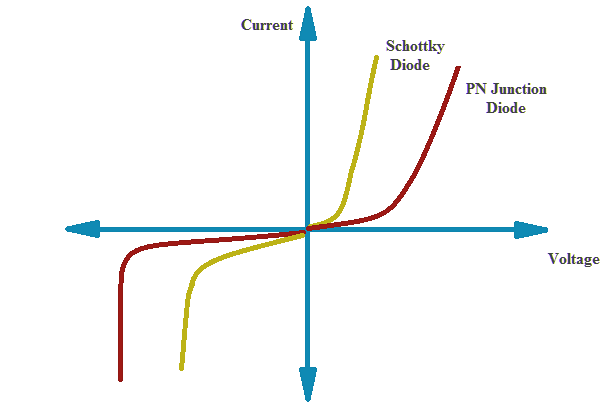Schottky diode is a special type of diode made up of metal and semiconductor materials. The schottky diode is named after the name of the scientist Walter H. Schottky, who had discovered the diode for the first time. This diode is also known as surface barrier diode. It is also known as hot carrier diode.
The power drop in this diode is very low as compared to other PN junction diodes. The forward voltage drop in the normal diodes varies between 0.6 volts to 1.7 volts, whereas the schottky diode has the forward voltage drop variation between 0.15 volts to 0.45 volts.
The lower voltage drop in a schottky diode increases the switching speed of the diode. The fast switching of the diode hence improves the efficiency of the diode. In a metal-semiconductor schottky diode, the metal is treated as the positive anode terminal and the semiconductor is treated as the negative cathode terminal.
There is a junction formed in between these anode and cathode terminals of the diode. This junction behaves as the barrier inside the diode. Hence, the diode is termed as barrier diode. Due to the presence of low voltage drop across the terminals of the diode, the Schottky diode is also known as a low voltage diode.
Schottky diode symbol
The symbol of a schottky diode is shown in figure 1.

Schottky diode construction
The basic construction of the Schottky diode is shown in figure 2.

The construction of a Schottky diode includes the use of metal and semiconductor materials, where the metallic terminal acts as the anode and the semiconductor terminal acts as the cathode terminal of the diode. Different types of metals such as gold, silver, tungsten, and gallium may be used as the semiconductor of the device.
Depending on the materials used in the construction of the diode results in different characteristics in the schottky diode. When the metal is combined with the semiconductor material, it forms the path for the carriers.
Since there is no P-type semiconductor material present with the N-type semiconductor; hence there is no occurrence of any depletion layer. This provides no space to store the charged particles in the diode.
Schottky diode working
After the combination of the metallic and the semiconductor materials, the majority charged carriers of the semiconductor move towards the metallic region. These fast-moving electrons of the semiconductor material are the hot carriers of the diode.
These fast-moving negative charge carriers generate a layer of charge-free carriers which acts as a barrier to the flow of electrons. This region is called the surface barrier of the diode. In the forward biased condition, the negatively charged carriers overcome the poor surface barrier and continue the conduction.
In the reverse biased condition, the strength of the surface barrier increases and the conduction decreases. The small current in the diode in the reverse biased condition is known as the leakage current. But, the increased reverse-biased destroys and current increases sharply at the reverse breakdown voltage.
Schottky diode V-I characteristic
The V-I characteristic of the schottky diode is the same as a normal PN junction diode but differs in the amplitude of the forward and the reverse breakdown voltages at the same applied voltage. Both the forward and the reverse breakdown voltages occur earlier than that of a normal PN junction diode as shown in figure 3.

Schottky diode advantages
A Schottky diode possesses the following advantages
1. The capacitance present in the Schottky diode is negligible. Hence, there is no storage of charged carriers.
2. The power drop or the voltage drop in a Schottky diode is lower than that of a normal PN junction diode.
3. The Schottky diode has a high switching speed.
4. The reverse recovery time required for the diode is less.
5. The efficiency of the diode is high.
6. The voltage required for the diode to turn-on is low.
7. The diode can operate in high-frequency devices.
8. The strength of the barrier potential in the Schottky diode is less.
Schottky diode disadvantages
The disadvantages of the Schottky diodes are as follows.
1. The use of metal makes the device costly.
2. The diode obtains a lower reverse breakdown voltage than that of a normal PN junction diode.
3. The sudden increase in the reverse breakdown current may damage the Schottky diode.
Schottky diode applications
The applications of a Schottky diode are as follows.
1. In the transistor-transistor logic circuit, the Schottky diode is used.
2. To prevent transistor saturation, the Schottky diode is used in voltage clamping and clipping.
3. The appliances that require fast switching, the Schottky diode can be used.
4. The Schottky diodes are used as a diode rectifier.
5. In digital computers, these diodes are used.
6. In the device that operates in high-frequency, the Schottky diodes are used.
7. The appliances used as detectors use Schottky diodes.
8. The Schottky diode is used also for protection purposes in various appliances.
9. The digital computers use Schottky diodes.
10. Nowadays, in solar cell appliances, the Schottky diodes are used frequently.
Author
Sunmoni Gohain
NIT Silchar
